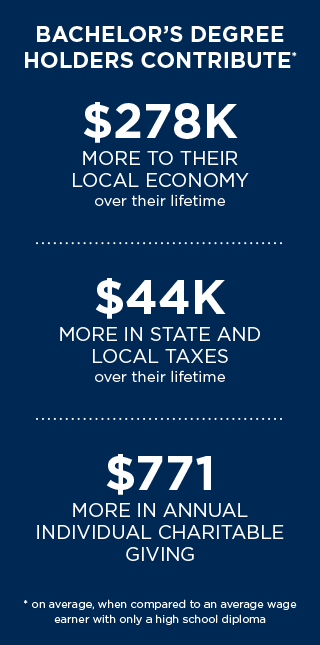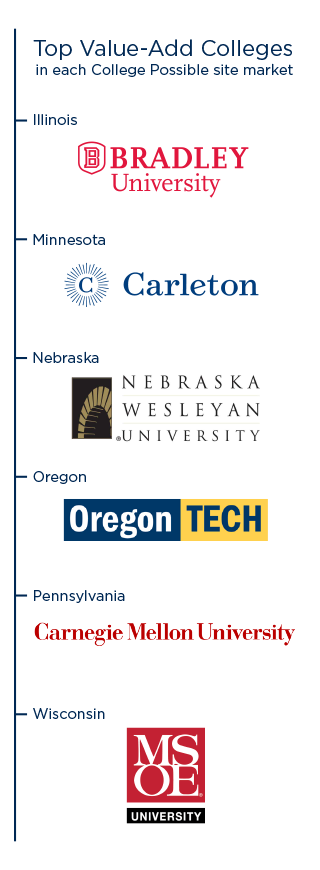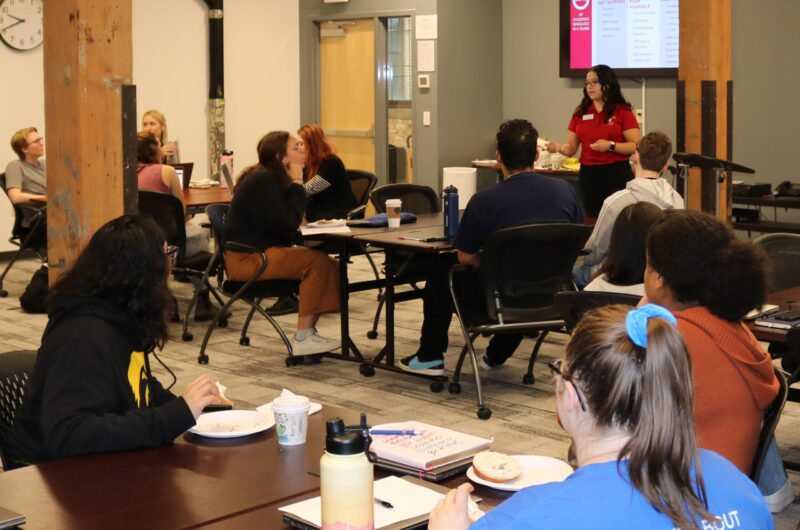Attending college isn’t solely about economic value, future earnings or vocational skills. There are intangible benefits in the opportunity for a student to fulfill their full potential. But as student debt balloons and national unemployment rates dip, prospective college students and their families are left wondering whether a college education is worth the investment. While student perceptions may be in flux, our communities can see the undeniable benefit of college graduates — and the unquestionable power held within the institutions that cultivate them.
With six locations across the country, College Possible operating sites witness the economic impact of a four-year degree for the students we serve both locally and collectively. Pulling together data from our local communities, this reveals that although each city has its nuances, educational attainment overwhelmingly benefits individuals and their communities in a variety of ways.
Local Impact
Just how much are college alumni financially contributing to local communities? Over the course of a lifetime, the average bachelor’s degree holder will funnel $278,000 more into local economies than the average wage earner with only a high school diploma. These same alumni will also contribute $44,000 more in local and state taxes that advance civil services, enhance infrastructure, fund public schools and support the arts.
 Many institutions of higher learning — particularly large public research universities — track the economic impact of their graduates. In College Possible’s Minnesota site market, the University of Minnesota system alone produces $8.6 billion in economic activity for the state, including jobs, research and improved health outcomes. More pointedly, University of Minnesota alumni who reside in-state will contribute $256 billion to the local economy over the course of their careers.
Many institutions of higher learning — particularly large public research universities — track the economic impact of their graduates. In College Possible’s Minnesota site market, the University of Minnesota system alone produces $8.6 billion in economic activity for the state, including jobs, research and improved health outcomes. More pointedly, University of Minnesota alumni who reside in-state will contribute $256 billion to the local economy over the course of their careers.
Similar trends are evident in other College Possible markets. A 2015 study found that alumni of the University of Illinois system contributed $9.5 billion into the local economy during the analysis year. Illinois residents will also benefit from the $29.1 billion in added state revenue over the course of U of I alumni’s career.
Earning a four-year degree boasts a personal benefit of nearly $2.3 million in total lifetime earnings for graduates — 84 percent more than those with only a high school diploma — but research suggests that a college-educated workforce could have a positive impact for all wage earners. Economist Enrico Moretti found that just a one percent increase in the college-educated workforce increased wages for workers who did not complete high school by 2.2 percent, high school graduates by 1.3 percent and those who completed some college by 1.2 percent.
Many policymakers acknowledge the vast benefits colleges, universities and their graduates pose for their cities and states, and have intensified their goals for educational attainment for their constituents.
Kaohly Her, policy director for Mayor Melvin Carter in the city of St. Paul, said she believes higher education connects students to vital resources, financial opportunities and social capital, and as a result, warrants government support.
“Local governments have a great responsibility to invest in educational opportunities. They are the connectors between educational institutions, employers and residents to initiatives and opportunities, which ultimately lead to a strong workforce,” she said.
The City of St. Paul is already thinking creatively about ways to increase educational achievement. This spring, Mayor Carter launched a task force to help establish a $50 College Savings Account (CSA) for all children in the city. While the initial deposit may not seem like much, the investment symbolizes the community’s commitment to its youngest generations.
“Mayor Carter believes that every child born in St. Paul deserves to know how important they are to the future of the city,” Her said. “He believes in the potential of all children, and that when we invest in them, they will go to college, graduate and come back to invest in the community.”
The State of Oregon, home to College Possible Portland, is also thinking critically about its residents’ educational attainment. In 2011, Oregon set forth one of the nation’s most aspirational education goals known as “40-40-20.” By 2025, the state strives for 40 percent of Oregonians to hold a four-year degree, 40 percent to hold a two-year degree and 20 percent to earn a high school diploma.
Kyle Ritchey-Noll, executive director of Oregon Learns believes there are key activities policymakers must address to make “40-40-20” a reality. “To accomplish its ambitious education attainment goals, Oregon must focus policies and systems to address education gaps and disparities before kindergarten; support and scale best student-centered practices in teaching and learning that achieve stronger, more equitable student outcomes; and connect education more closely to careers so students can see the connection between their education and the future.”
Realizing this relationship between schooling and success could be key for students across markets. But studies show that some regions may have an advantage.
Measuring Worth
Although a four-year degree generally enhances financial outcomes, some markets favor and reward graduates more than others. Of the College Possible sites, Philadelphia ranks among the nation’s large metro areas where a four-year degree is the highest value-add for alumni in the job market. Bachelor’s degree holders in this city add an average of $8,614 to their salaries compared to their peers.

Other College Possible markets, such as Minneapolis and Chicago, rank among the metro areas with the least value added by a four-year degree at $2,036 and $2,984 respectively. Following the laws of supply and demand, these findings perhaps reflect the high concentrations of four-year graduates within these cities, which rest at 47.7 percent and 36.5 percent respectively, compared to 26.3 percent in Philadelphia. But even on the low end of value returns, these cities’ graduates have a sizable advantage over their peers who forewent college, especially over the course of a career.
Beyond location of an education, it will come as no surprise that college alumni experience varying economic outcomes as a result of their degrees, but it appears college rankings and admission requirements are not always the best indicator of an institution’s return on investment for alumni. Instead, a recent Brookings report suggests that the type and quality of a few key factors determines the economic value-add for alumni. The report notes key factors such as curriculum value, reported alumni skills, STEM orientation, college completion rates and student aid to analyze how alumni fare after graduation.
A few of the institutions topping the high value-add list are big names like MIT and Cal Tech, but the majority of institutions noted for their economic returns are less likely to be known on a national scale. This data is significant, because it alludes to the importance of college knowledge when approaching the college application process — a factor that may be lacking for many students from low-income, first-generation or otherwise underrepresented backgrounds. Undermatching — the process by which high-achieving students enroll in less-competitive colleges — disproportionately affects students from low-income and minoritized backgrounds, which impacts these students’ likelihood to graduate and profit from the advantages of a four-year degree.
Today, a host of education access nonprofits work to address these disparities by helping students think critically about college fit, access fee waivers, apply for scholarships and secure fly-in visits. College Possible’s partnership with CollegePoint, an initiative funded by Bloomberg Philanthropies, specifically helps high-achieving low and middle-income students apply to top tier schools. However, CollegePoint is only able to reach 65,000 students nationwide. This reality implies that more must be done on a public level to measure and advertise the value-add of institutions in order to benefit students, their families and even policymakers. Making this information available could open doors for students that, in turn, have high returns for their careers and communities.
Giving Back
One such return could be the ability to give back. The Lumina Foundation reports that as educational attainment increases, so do levels of giving. In fact, individuals with bachelor’s degrees give an average of $1,304 in charitable contributions annually, compared to around $533 for those without a post-secondary degree.
These funds have a unique impact on local economies. Philanthropic efforts have the power to fill in gaps left by market failures and funnel support toward issue areas overlooked by public funding. Since donors hold the decision-making power with their own dollars, they are free to support efforts labeled too risky for taxpayer approval, or movements that are too new or controversial for larger grant funding, such as grassroots organizations. Much like voting, making a charitable contribution allows an individual to have a direct say in the social conditions of their local community — only constituents don’t need to wait for an election cycle to do so.
In tandem with charitable contributions, those with a four-year degree are also more likely to volunteer for local causes and organizations. A total of 40.3 percent of bachelor’s degree holders volunteer compared to 17.4 percent of high school graduates and 28.0 percent of those with some college. These labor hours contribute an estimated value of $1,665 annually per individual to compound already significant rates of giving.
Implications
Market data reveals that degree holders enable important economic growth for local and state economies in terms of increased earnings, buying power, productivity spillover and capacity to give back philanthropically. But these statistics also unveil the deeper power institutions wield as gatekeepers to economic advancement.
Higher education institutions take pride in their ability to uplift local economies, but need to take further responsibility for the ways they also uphold the economic status quo. When colleges and universities make decisions that cause them to enroll fewer students from low-income or traditionally underrepresented backgrounds — or don’t make investments that allow them to graduate these students — they enact barriers with far-reaching impacts, both financial and personal.
Likewise, state and local governments have a clear incentive to invest in education and those institutions that cultivate high value-add for their graduates. In some cases, this means investing in earlier levels of education to prepare students for post-secondary opportunities, and in other cases, this means increasing public funding that will allow for quality teaching staff, financial aid and the implementation of student support systems that will boost retention and graduation rates.
It is clear that making higher education systems more accessible and equitable will pay dividends in the form of economic prosperity, but this task cannot be accomplished alone. Campuses, policymakers, community organizations and the public must work together to change our current systems and make the possibility of a degree a reality for all.
by Abi Tupa



